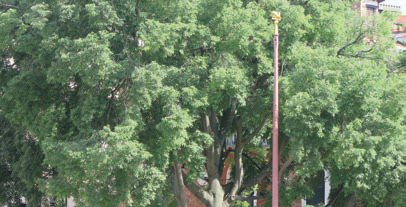Keith Sacre, Sales Director at Barcham Trees shares his thoughts on the impact of climate change on Trees
A number of weeks ago, I attended the Landscape Below Ground Conference at the Morton Arboretum in Illinois, USA. The conference was a great success, including a frequently repeated joke amongst the locals: ‘We are OK: we don’t have climate change’. This was obviously all ‘tongue in cheek’ referring to their current President’s denial that such a thing even exists. There is a reality to this though in that the real implications of climate change are unknown with speculative forecasts fuelling debate. However, some of the emerging certainties include: sea level rise affecting coastal zones, increased winter precipitation in northwestern Europe, temperature rises much larger than the global average for northern Europe and an increase in warm temperature extremes in central and eastern Europe.
Rainfall across the British Isles and Ireland is predicted to fall by between 5% and 15%. On top of this, there is the unpredictability of extreme weather events, which it is suggested will increase in frequency.
The concept of climate change, together with the problems it poses for the future, is taken seriously across the world, (except for the ‘White House’ perhaps), with many international reports having been published in recent years discussing and laying out the implications in both a general and specific way. ‘The Impact of Climate Change on American Forests’, ‘Why Forests? Why Now, The Science, Economics and Politics of Tropical Forests and Climate Change’, and ‘Boreal Forest and Climate Change’ are just a few of the titles focusing on the impact of climate change on natural and plantation forests to hit the bookshelves in recent years.
So, what are the implications of the above, surrounded with its veil of uncertainty, for the nursery industry?
One of the most likely outcomes is the demand for a more resilient urban forest – one which can cope with the challenges of unpredictable weather and the likely increase in the spread of imported pest and disease. The UK has already been badly affected by Ash Die Back and Oak Processionary Moth; and Plane Wilt, Emerald Ash Borer and Asian Long Horned Beetle are on the horizon. Many professionals suggest that the most effective method of proofing against serious problems is by increasing tree diversity within the urban tree population.
This calls into question the resilience of current urban tree populations. At the conference referred to above, a speaker from Shanghai reported that there are over 1.2 million street trees in the city represented by 30 species, yet only two species accounted for 75% of the total. In Barcelona, three species account for 79% of the tree population; in Pittsburgh USA three species account for 45% of the total population, and in the London Borough of Camden six species account for 61% of the population. These figures are taken from a few of the many i-tree studies carried out both in the USA and mainland Europe. If tree population resilience is to be achieved through species diversity, then it would seem that none of the populations referred to above are going to be resilient into the future.
It is likely then that the nursery industry is going to be asked to produce a wider range of species, some of which it is going to be unfamiliar with. Already in the UK, there is an increased demand for Celtis australis and C. orientalis, Styphnolobium japonicum, Ostrya capinifolia, Koelruetaria paniculata and Carrya illinoiensis to name but a few. The production of these species is presenting challenges to a nursery industry unused to propagating them, where this is possible, and growing them to a standard in which they will survive in the urban environments of the future.
Then there is the question of provenance. At this moment in time, most tree nurseries would be unable to state with any confidence where the selection of a species they produce originated from. The natural range of a species can vary enormously. For example, the natural range of Liriodendron tulipifera extends from New England to Florida in the Eastern USA. Climatic conditions between the northerly and southerly extremes of the range are obvious, and this has implications, with regard to the genotype being offered by the nursery and the ability of that genotype to thrive as the predicted impacts of climate change begin to emerge into reality. So, the identification of provenance is likely to become increasingly important as the environmental conditions of the city are matched with the natural environment in which trees grow.
The question of imported pest and disease has already been mentioned but the demand for an increasing number of species to be available from the nursery can actually fuel the demand for imported tree stock. This is particularly true where a species cannot be propagated or produced economically by a home nursery – with the only way of supplying the tree in question through importing it. Inevitably this increases the risk associated with imported pest and disease.
The demand for high-quality tree stock is also likely to increase. I have recently been lucky enough to travel in the UK, and to Canada, USA, Australia, Holland and Russia. There would appear to be a general consensus that the quality of tree stock offered in general by the nursery industry is not good enough. I cannot verify this, but I have seen some real horrors, not only supplied by the nursery industry but also planted out into the landscape by unquestioning contractors.
One of the likely impacts of climate change is that our cities will become warmer, and the provision of shade and cooling will become increasingly important. It is already apparent that many municipalities are looking at trees to mitigate some of the more extreme effects. Many cities are now beginning to set targets for increased tree canopy cover and have set ambitious tree planting programmes in place. If this trend continues, and the evidence suggests that it will, then the demand for trees from the nursery industry is likely to increase proportionately. However, these trees will have to be fit for purpose if the continued investment is to be made in tree planting. Investment is fuelled by success, and rows of dead trees through poor quality tree stock from the nursery, poor planting and poor maintenance is unlikely to stimulate repeated investment.
Has the nursery industry the skills it needs to capitalise on what would appear to be a golden opportunity? Again, the indications are not good. It would appear to be increasingly difficult to attract young people to work on the land, and many of the old craft skills associated with high-class nursery practice appear to be slowly disappearing. In the UK many of the growers currently producing trees are the same folk who were in place 20 or so years ago.
I think it safe to say that climate change is real. Some of the realities of that change have been outlined above together with some of the implications of those changes for the nursery industry. These are only the immediate implications of climate change, and there are many more which need detailed discussion.
However, the one thing I am certain of is that the tree nursery has an important role to play in the development and resilience of the urban forest in face of climate change. It has the opportunity to become central to the debate rather than remain peripheral. It will be interesting to see how many are capable of rising to the challenge. ✽









